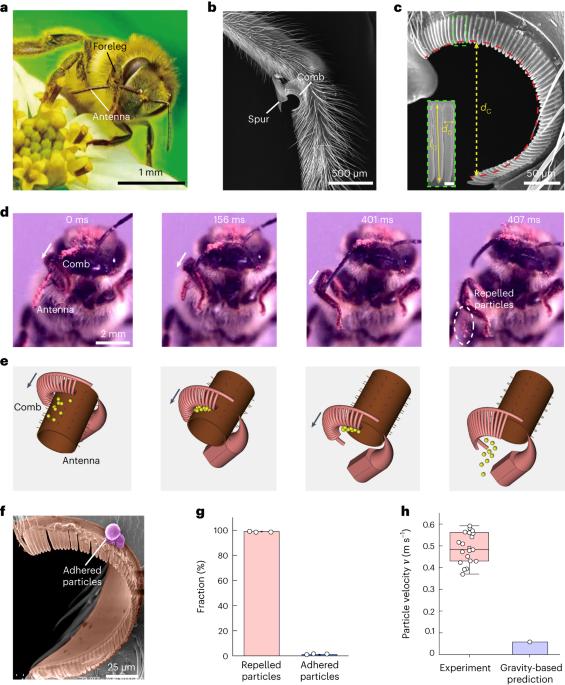蜂巢式刚度梯度放大弹射器,具有固体颗粒排斥性。
IF 38.1
1区 材料科学
Q1 MATERIALS SCIENCE, MULTIDISCIPLINARY
引用次数: 0
摘要
排斥外来物质的天然表面无处不在,对生物体至关重要。尽管在许多生物体中,由表面能驱动的液体具有显著的排斥性,但将微小的固体颗粒从表面排斥是罕见的。主要的挑战在于在微观尺度上惯性相对于粘性的不利比例,以及固体无法释放表面能。在这里,我们报道了蜜蜂梳子上一种以前未被探索的固体排斥性:一种弹射器状的效果,在梳理脏的触角进行自我清洁后立即喷出花粉。纳米压痕测试显示,38微米长的梳状物的刚度梯度从~25跨越了近两个数量级 尖端至~645的MPa MPa。这显著增加了弹性能量存储,并加速了随后转化为动能。能量存储和转换的增强使颗粒原本较弱的惯性超过了其粘附力,从而抑制了不利的结垢效应,并实现了传统均匀设计中不可能实现的固体排斥性。我们利用这一点构建了一个弹性体仿生刚度梯度弹射器,并展示了其通用性和实用性。我们的发现促进了对自然弹射器现象的基本理解,有可能开发生物启发的刚度梯度材料、基于弹射器的致动器和机器人清洁器。本文章由计算机程序翻译,如有差异,请以英文原文为准。

Honeybee comb-inspired stiffness gradient-amplified catapult for solid particle repellency
Natural surfaces that repel foreign matter are ubiquitous and crucial for living organisms. Despite remarkable liquid repellency driven by surface energy in many organisms, repelling tiny solid particles from surfaces is rare. The main challenge lies in the unfavourable scaling of inertia versus adhesion in the microscale and the inability of solids to release surface energy. Here we report a previously unexplored solid repellency on a honeybee’s comb: a catapult-like effect to immediately eject pollen after grooming dirty antennae for self-cleaning. Nanoindentation tests revealed the 38-μm-long comb features a stiffness gradient spanning nearly two orders of magnitude from ~25 MPa at the tip to ~645 MPa at the base. This significantly augments the elastic energy storage and accelerates the subsequent conversion into kinetic energy. The reinforcement in energy storage and conversion allows the particle’s otherwise weak inertia to outweigh its adhesion, thereby suppressing the unfavourable scaling effect and realizing solid repellency that is impossible in conventional uniform designs. We capitalize on this to build an elastomeric bioinspired stiffness-gradient catapult and demonstrate its generality and practicality. Our findings advance the fundamental understanding of natural catapult phenomena with the potential to develop bioinspired stiffness-gradient materials, catapult-based actuators and robotic cleaners. Nanoindentation of the microscale honeybee comb reveals a stiffness gradient that spans two orders of magnitude, which amplifies the catapult effect and facilitates solid particle repellency. By leveraging this, the study presents the fabrication of scaled-up, bioinspired stiffness-gradient elastomeric catapult-like soft actuators.
求助全文
通过发布文献求助,成功后即可免费获取论文全文。
去求助
来源期刊

Nature nanotechnology
工程技术-材料科学:综合
CiteScore
59.70
自引率
0.80%
发文量
196
审稿时长
4-8 weeks
期刊介绍:
Nature Nanotechnology is a prestigious journal that publishes high-quality papers in various areas of nanoscience and nanotechnology. The journal focuses on the design, characterization, and production of structures, devices, and systems that manipulate and control materials at atomic, molecular, and macromolecular scales. It encompasses both bottom-up and top-down approaches, as well as their combinations.
Furthermore, Nature Nanotechnology fosters the exchange of ideas among researchers from diverse disciplines such as chemistry, physics, material science, biomedical research, engineering, and more. It promotes collaboration at the forefront of this multidisciplinary field. The journal covers a wide range of topics, from fundamental research in physics, chemistry, and biology, including computational work and simulations, to the development of innovative devices and technologies for various industrial sectors such as information technology, medicine, manufacturing, high-performance materials, energy, and environmental technologies. It includes coverage of organic, inorganic, and hybrid materials.
 求助内容:
求助内容: 应助结果提醒方式:
应助结果提醒方式:


